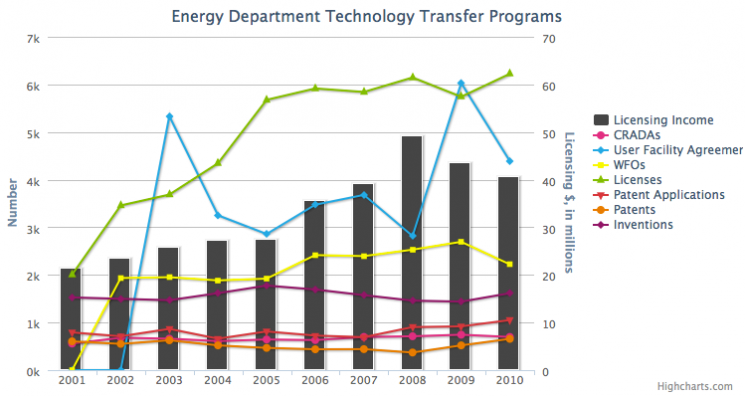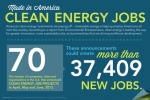
In order to transform our nation’s energy system and secure U.S. leadership in energy technologies, we must maximize the potential of the scientific discoveries made in our National Laboratories.
In 2010 alone, the Energy Department’s 17 National Laboratories and 5 facilities executed more than 13,500 technology transfer transactions. These transactions include a range of other research and development agreements as well as the licensing of laboratory technologies, negotiated by technology transfer offices across the Department. Technology Transfer offices at the laboratories and facilities work closely with the Energy Department to provide access for industry and academia to the technologies, expertise and unique facilities – helping to make U.S. companies and the U.S. economy more competitive.
Learn more about the various ways you can work with the National Laboratories:
- CRADAs (Cooperative Research and Development Agreements): The industry partner enters into a cost-sharing agreement or provides funds for collaborative work and sharing of intellectual property and data. For example, the novel lithium ion battery research underway at Oak Ridge National Laboratory has yielded a long-term partnership between the lab and Dow Kokam. By supporting the research & development at ORNL, Dow Kokam has been able to efficiently optimize its materials and manufacturing processes. Ultimately, this agreement will enable the company to provide advanced and economical battery solutions for the industrial and consumer markets.
- Work for Others: Laboratory experts conduct sponsored research and development for a non-federal partner that funds the work directly through the lab. Work for Others permits the funding partner to maintain intellectual property and data rights. Sandia National Laboratories’s alliance with General Motors includes a Work for Others agreement: Sandia researchers have recently completed a prototype hydrogen storage system for GM vehicles with design tools that will save GM significant costs and time.
- User Facilities Agreements: The industry partner receives access to unique facilities and equipment available at the laboratories to conduct research and development activities. The non-federal user of the facility pays the full cost of conducting the research at the lab and may maintain intellectual property and data rights. Users who agree to publish the research results are not required to cover the cost of the use of the facility. See a listing of Designated User Facilities. For example, the National Synchrotron Light Source (NSLS) at Brookhaven National Laboratory attracts about 2,500 scientists each year from industry, academia, as well as other labs to use the facility's powerful x-rays, ultraviolet light and infrared light.
- Licenses of Inventions and Copyrights: Laboratory technologies and software are made available to industry for further research and commercial development. For example, Berkeley National Laboratory scientists recently licensed their Ion Mobility Analysis technology to Quest Diagnostics, Inc. and Berkeley HeartLab Inc. This more thorough cholesterol assessment test will help identify individuals who may have no idea that they are at risk for heart disease (which accounts for roughly half of 1.5 million heart attacks a year).
In 2010, technology transfer transactions included more than 700 CRADAs, 2,200 Work for Others agreements, 4,400 user facility agreements, and more than 6,000 licenses. The technology transfer offices filed more than 1,000 patent applications, and logged more than 200,000 downloads of their copyrighted open-source software.
The laboratories provide information on patents, patent applications and available technologies by allowing you to search or browse market summaries of technologies available for licensing at the Energy Innovation Portal. The technologies include not only those developed by Energy Department laboratories, but many from Energy Department-funded research institutions as well.
In May, we launched the “America’s Next Top Energy Innovator Competition.” Under the program, newly created companies and budding entrepreneurs can options to license up to three patents in one technology area from a single Energy Department National Laboratory are available at the low cost of only $1,000. The program defers patent costs and upfront option fees. Technologies available for licensing through this program can be found here.
Stay tuned over the next week for Energy.gov's Commercialization series showcasing many technologies from the National Laboratories.





